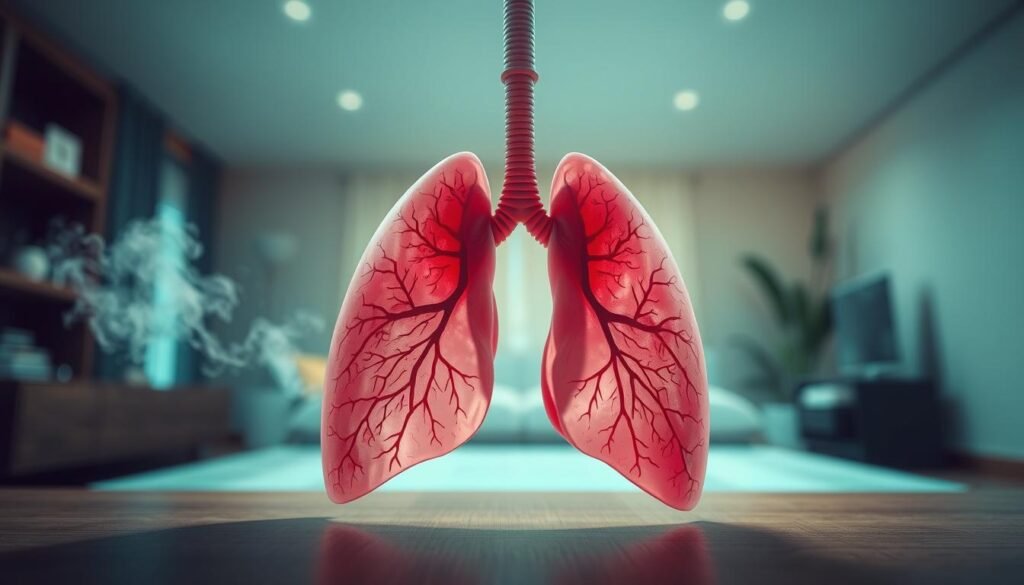Almost 90% of lung cancers are non-small cell lung cancer (NSCLC). Stage 1 adenocarcinoma is a common yet treatable form. It shows why early detection is key to better options and survival rates. For instance, survival rates are as high as 92% for stage IA1 and 68% for stage IB. This highlights the need for quick diagnosis and action. This piece will explore what stage 1 adenocarcinoma lung cancer involves. We’ll look at its symptoms, how it’s diagnosed, treatment choices, and support for those dealing with it.
Key Takeaways
- Stage 1 adenocarcinoma lung cancer is divided into subcategories 1A and 1B.
- Stage 1A tumors are minimally invasive and smaller than 3 cm, while Stage 1B tumors range from 3 cm to 4 cm.
- Common treatments include surgery, targeted therapy, and chemotherapy.
- Recent advancements have led to improved therapies for lung cancer, focusing on specific genetic markers.
- Early diagnosis can lead to a high cure rate, with 5-year survival rates varying based on cancer stage.
- Understanding the TNM staging system is vital for assessing the extent of lung cancer.
- Resources such as cancer preparedness and management are essential for navigating treatment.
Understanding Lung Cancer Staging
Lung cancer staging is crucial for understanding the disease’s extent and guiding treatment. It uses the TNM system, which means Tumor, Node, and Metastasis. This approach assesses tumor size (T), lymph node involvement (N), and cancer spread (M).
Stage 1 lung cancer means the disease hasn’t spread. It’s divided into sub-stages 1A and 1B. For stage 1, the primary tumor is no bigger than 4 cm. It hasn’t spread to lymph nodes or other parts of the body. Early-stage lung cancer often leads to better treatment results.
Knowing the details of stage 1 lung cancer is key in its staging. About 63% of those with localized non-small cell lung cancer (NSCLC) survive five years or more. Catching cancer early makes treatment more effective. For example, the U.S. Preventive Services Task Force suggests yearly low-dose CT scans for some people, based on age and if they’ve smoked.
To show what lung cancer staging covers, look at this table:
| Stage | Tumor Size | Lymph Node Involvement | Metastasis |
|---|---|---|---|
| Stage 1A | ≤3 cm | No | No |
| Stage 1B | >3 cm and ≤4 cm | No | No |
| Stage II | Any size | Yes | No |
| Stage III | Any size | Yes | Yes (local spread) |
In summary, the right lung cancer staging is vital for treatment and prognosis. Stage 1 lung cancer, especially adenocarcinoma, has a better outlook than other types like squamous cell or large cell carcinoma. This highlights early detection and thorough staging to improve patient outcomes.
What is Adenocarcinoma Lung Cancer?
Adenocarcinoma is a kind of lung cancer affecting around 40% of all lung cancer cases. It starts in the glandular cells of the lungs which make mucus and fluids. It usually grows more slowly than other lung cancer types.
It’s more common in non-smokers and is seen more in women than men. Young people aged 20 to 46 with lung cancer likely have adenocarcinoma. Among non-smokers, about two-thirds of adenocarcinoma patients are women.
Several key driver mutations exist in non-small cell lung cancer adenocarcinoma. These genetic changes help decide treatment options. Nine mutations have treatments approved by the FDA. Assessing cancer DNA, PD-L1 protein levels, and tumor mutational burden (TMB) is crucial in choosing the right treatment for adenocarcinoma.
Surgery, especially lobectomy, is often used when the tumor hasn’t spread. It involves removing a whole lung lobe. When the cancer is more advanced, chemotherapy usually involves two drugs. External beam radiation therapy (EBRT) is also a common treatment for non-small cell lung cancer, including adenocarcinoma.
Stage 1 Adenocarcinoma Lung Cancer: Key Characteristics
Stage 1 adenocarcinoma lung cancer is a crucial point in cancer stages. It shows the cancer is still only in the lung. Doctors use this information to pick the best treatments and aim for the best results.
Definition and Classification
Stage 1 is about the size and place of the tumor. It splits into 1A and 1B, showing different features. Knowing the stage well helps plan treatments better. The cancer classification system tells doctors that a tailored approach works best.
Subtypes: Stage 1A and 1B
Stage 1A has tumors under 3 centimeters, just in the lung’s tissue. But, stage 1B tumors are 3 to 4 centimeters or might spread nearby. This tumor size difference is key. It guides the choice of treatments. Doctors look at these details to suggest the right treatment plans.
| Stage | Tumor Size | Characteristics |
|---|---|---|
| Stage 1A | Less than 3 cm | Localized, no lymph node involvement |
| Stage 1B | 3 to 4 cm or involved adjacent structures | Localized, no lymph node involvement |
Common Symptoms of Early-Stage Lung Cancer
Knowing the symptoms of early-stage lung cancer is key for quick action. Many don’t show symptoms until it’s late. But, some people do have signs linked with early lung cancer. Catching and acting on these early can help greatly in diagnosing and treating lung cancer.
Recognizing Symptoms
The symptoms of early-stage lung cancer can be different for everyone. Some people might not show any symptoms, while others could notice:
- A persistent cough that persists or intensifies
- Coughing up blood or rust-colored sputum
- Chest pain that may worsen with deep breaths
- Unexplained weight loss and loss of appetite
- Shortness of breath or wheezing
- Unusual fatigue or weakness
- Recurrent respiratory infections like bronchitis or pneumonia
It’s vital to know these symptoms for quick intervention. Not all symptoms mean cancer, so it’s important to get a professional diagnosis. This helps to start the right treatment sooner.
When to Seek Medical Attention
It’s crucial to seek medical attention if you notice unusual respiratory symptoms. An early check-up can help catch lung cancer when it’s easier to treat. This improves your treatment options and chances. Immediate medical help is needed if you experience:
- A sudden increase in the severity of cough
- Blood in sputum or a drastic change in cough patterns
- Persistent chest pain
- New onset of wheezing or shortness of breath
Watch your health closely and act fast when you notice symptoms. Early action is key to managing lung cancer well. Remember, early detection and treatment are very important.

| Symptom | Description |
|---|---|
| Persistent Cough | A cough that does not go away or worsens over time. |
| Coughing Up Blood | Presence of blood or rust-colored sputum. |
| Chest Pain | Instability or pain in the chest, especially when breathing deeply. |
| Unexplained Weight Loss | Significant weight loss without trying to diet or exercise. |
| Shortness of Breath | Difficulties in breathing, especially during physical activities. |
| Fatigue | Excessive tiredness or weakness affecting daily activities. |
Diagnostic Techniques for Stage 1 Lung Cancer
Identifying stage 1 lung cancer involves using various techniques. These are key to finding adenocarcinoma early, which helps a lot with treatment. CT scans are very important for this, as they provide detailed images for diagnosing and assessing lung nodules.
Role of CT Scans in Detection
CT scans are crucial for finding lung cancer early on. They offer detailed images of the lungs, unlike standard x-rays. This lets doctors see the size and location of tumors clearly, even small ones that might be cancer. They are especially useful for people over 50 who have smoked a lot, recommending them for screening.
Importance of Pulmonary Nodules Assessment
It’s important to check pulmonary nodules carefully. While often not cancerous, they can sometimes signal lung cancer. Tools like PET scans and more CT imaging help assess these nodules. Biopsies may also be done to confirm if it’s cancer. Monitoring these nodules is key in finding cancer early and deciding the next steps for treatment.
Stage 1 Adenocarcinoma Lung Cancer Treatment Options
Treatment for stage 1 adenocarcinoma lung cancer looks at each patient’s needs. Plans often mix surgery, targeted therapies, and chemotherapy. This mix aims for the best outcome.
Surgical Interventions
Surgery is a key method to combat stage 1 adenocarcinoma lung cancer. It includes:
- Lobectomy: This is where a lobe of the lung is removed. It’s a common choice.
- Segmentectomy: This removes a part of a lobe, best for small tumors.
- Sleeve resection: This surgery takes out part of the bronchus and the tumor.
The goal of surgery is to remove cancer but keep as much healthy lung as possible. This often leads to better survival odds.
Targeted Therapy and Chemotherapy
Some may get more treatment after surgery, like targeted therapy or chemotherapy. Targeted therapy attacks cancer’s growth paths. It’s a care tailored to the patient. Chemotherapy, using drugs like cisplatin and vinorelbine, targets fast-growing cancer cells. It’s chosen based on patient risk factors.
Radiation Therapy Alternatives
Radiation therapy is another path for those who can’t have surgery. Stereotactic body radiation therapy (SBRT) uses focused radiation to kill tumors. It’s good as a first step or alongside surgery. This improves treatment success and offers an option when surgery isn’t possible.
Prognosis for Stage 1 Adenocarcinoma Lung Cancer
The outlook for those with stage 1 adenocarcinoma lung cancer is generally good. This is because finding and treating the cancer early can lead to high survival rates. The SEER Database shows that the 5-year relative survival rate for this stage is about 65%. This fact highlights how crucial early detection is for effective treatment.
Survival Rates Explained
Survival rates for stage 1 adenocarcinoma lung cancer can differ.
| Stage | 5-Year Survival Rate |
|---|---|
| 1a1 | 92% |
| 1a2 | 83% |
| 1a3 | 77% |
| 1b | 68% |
Age and health status affect lung cancer survival rates. For example, patients under 50 have a 5-year survival rate of 83.7%. But, survival rates decrease as people get older. For those aged 50-64, the rate is 67.4%. And it drops to 54.6% for those 65 and older.
Factors Influencing Prognosis
Several factors can impact the outcomes for those with stage 1 adenocarcinoma lung cancer.
- Overall Health: Survival is deeply affected by existing health conditions.
- Tumor Characteristics: The size and type of the tumor can change the prognosis.
- Genetic Influences: Certain gene mutations can lead to worse outcomes.
- Response to Treatment: How well treatments work is closely tied to survival.
Doctors advise getting personalized evaluations to better understand lung cancer outcomes. These consider each person’s health and how they respond to treatment. You can find more resources here. Also, information on early warning signs is available here.
Coping with a Lung Cancer Diagnosis
Getting diagnosed with lung cancer can turn your world upside down. For both patients and their loved ones, it’s a tough time. Finding support is key. It helps lift some of that heavy load. There are lots of resources out there, like support groups. These can really make a difference as you face this challenge.
Emotional Support and Resources
Right now, you might feel scared or alone. That’s natural. Talking to a therapist or joining a group can help a lot. They provide a place to share your feelings safely. You can find special resources just for lung cancer patients. They give advice and can make your journey feel a bit easier. It’s also comforting to meet others going through the same thing.
Importance of a Multidisciplinary Care Team
To fight early-stage lung cancer, a team approach works best. This team is made up of different health experts. You have oncologists, surgeons, and others, all focused on you. They come up with treatments that are tailored just for your needs. Working together, they aim for the best results. They care about your physical and emotional health.

Research and Clinical Trials in Lung Cancer Treatment
Research into lung cancer is key to better treatment for stage 1 adenocarcinoma. Clinical trials let patients try new therapies not widely available yet. This gives them more options beyond standard care.
Immune therapies, especially checkpoint inhibitors, are exciting areas of study. They could be a first-line treatment for lung cancer. Also, testing tumors genetically helps make treatments that match the cancer’s genes.
The American Cancer Society points out lung cancer is the top cancer killer in the U.S. That’s why fast progress in research and trials is critical. For example, a new drug called sotorasib (Lumakras™) was approved in 2021. It targets a mutation in some non-small cell lung cancers.
Scientists are testing new methods like TIL therapy and cancer vaccines. These trials could greatly expand the number of treatments available. It’s vital to keep researching. Early detection can greatly improve chances of survival.
Preventive Measures and Risk Reduction
Adopting effective preventive measures is key in reducing lung cancer risk. Making certain lifestyle changes can greatly cut the chances of it coming back. It also boosts overall health. Healthy habits strengthen treatment effects and may lower cancer risk.
Lifestyle Changes to Consider
Several lifestyle adjustments can help reduce lung cancer risk and support well-being. Important actions include:
- Smoking cessation: Stopping smoking is vital. Health perks, like reduced lung cancer risk, start right away.
- Regular physical activity: Staying active keeps you at a healthy weight and strengthens your immune system.
- Balanced diet: Eating plenty of fruits and veggies benefits your lungs. But it can’t undo smoking’s harm.
- Avoiding environmental toxins: Staying away from bad substances, including radon, lowers lung cancer risks.
Research highlights the benefits of these lifestyle shifts. For example, the CARET study focused on certain nutrients’ effects on lung cancer. The American Cancer Society also points out eating right and exercising helps prevent cancer.

Making these lifestyle shifts helps in lowering cancer risk and improves life quality. By valuing health, you can actively reduce lung cancer risks. This supports your health journey.
Future Outlook for Lung Cancer Treatments
The way we treat lung cancer is changing quickly. Thanks to new research and technology, things are looking up. Doctors are now learning more about how lung cancer works. This helps them create better treatments. The goal? To make treatments that are just right for each patient’s unique type of cancer.
Innovations in Targeted Therapy
Lung cancer treatment is getting a big boost from new targeted therapies. These therapies focus on killing cancer cells without hurting the healthy ones. This means patients could feel better and live longer. Take medicines like osimertinib, for example. They’re doing wonders for patients with certain mutations. This is a big win in the fight against cancer.
Machine learning is another game-changer. It’s getting really good at spotting lung cancer types and mutations. In some cases, it’s accurate 97% of the time! This tech could lead to treatments that are tailored perfectly to each patient.
There’s also excitement around new kinds of treatments, like immunotherapies and drugs called selpercatinib and enalutamide. They target patients with certain genes. This approach is changing the game for treating early stage lung cancer and more.
If you want to catch lung cancer early, it’s good to know the first signs. Taking action quickly can make a huge difference. To learn about these early symptoms, check out early warning signs of lung cancer. It’s really important for getting the help you need fast.
Conclusion
Understanding stage 1 adenocarcinoma lung cancer involves getting to know about its diagnosis, treatment, and outlook. It’s crucial to spot this cancer early. This can greatly boost survival rates. Thanks to medical advances and a dedicated care team, patients now get treatments that really help them get better and live fuller lives.
New treatments and plans have changed how lung cancer care looks. Early-stage patients, especially those who get surgery, often have an 84.20% chance of surviving for 5 years. But, it’s important to know that lung cancer can come back 30% to 50% of the time after surgery.
Being active in your care and working closely with doctors can help improve your health. To dive deeper into lung cancer, check out this study. Knowing more and getting checked early can truly change the cancer journey for many people.